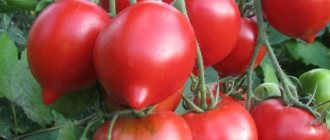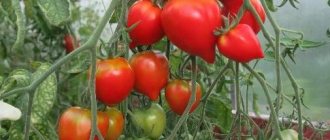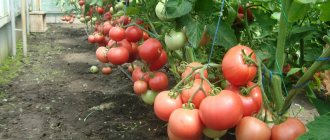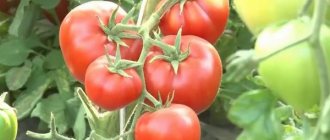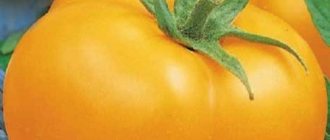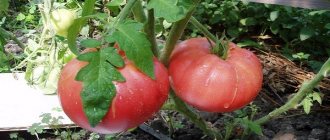Anniversary Tarasenko is a varietal tomato suitable for harvesting with brushes. The cultivar is high-yielding, produces red spherical fruits with a well-defined nose and is not a hybrid.
| Height | Landing location | Ripening time | Fruit color | Fruit size | Origin | Fruit shape |
| Tall | Greenhouse | Late ripening | Reds | Average | Variety | With spout |
Description of tomato variety Yubileiny Tarasenko: characteristics, growing region
Feodosiy Makarovich Tarasenko lived and worked in the Sumy region. He created many dozens of varieties and hybrids of tomatoes, including the legendary Hybrid-2, Podarok Polesie, Legend, etc. Moreover, the breeder was not a professional vegetable grower; he worked as a physics teacher at school. Jubilee Tarasenko is a variety that he created for his 75th birthday more than thirty years ago. In addition to developing new varieties, F. M. Tarasenko carried out extensive educational work and described in detail the technology for growing his largely unusual tomatoes.
For some unknown reason, the varieties created by a Ukrainian amateur are not registered in the State Register of the Russian Federation, although they are well known to our gardeners and loved by them. Because of this, there is often confusion with names. So, many companies sell Jubilee seeds, but their descriptions vary. Even the shape of tomatoes of this variety is described as both round and plum-shaped. Although it turns out that even in the old photos presented by the author, there are both tomatoes without a spout and with one, but they are all round.
Infographics: a brief description of the tomato variety Yubileiny Tarasenko
Brief description of the Yubileiny Tarasenko variety
All tomatoes bred by F. M. Tarasenko are significantly different from those familiar to us in that they grow in the form of a liana-shaped bush at least two meters high, and the tomatoes are collected in very large fan-shaped clusters. They contain several dozen fruits of average or above average size, as a result of which each cluster can weigh 3–4 kg. As a rule, large leaves resemble potato leaves.
All this applies to Jubilee Tarasenko. It is grown in all regions, both in greenhouses and in unprotected soil, but the yield is not equally record-breaking everywhere. Nevertheless, even in cold areas without shelter, 2-3 huge clusters manage to set and ripen on the bushes, as a result of which quite decent harvests are collected. And in greenhouses or in the south, at least five clusters are formed, and up to 20 kg of tomatoes are harvested from one plant. Of course, without qualified care this figure is lower, sometimes twice as much.
That's why this variety is called a liana: the stems wrap around obstacles, while carrying huge heavy brushes
Jubilee Tarasenko is a mid-season variety; about four months pass from sowing the seeds to the ripening of the first tomatoes. The fruits are beautiful, round, often with a sharp nose, red-orange in color. They are dense, which allows you to transport crops over any distance. The taste is rich, typically “tomato”. The size of the fruits within the cluster is not uniform: there are small ones, suitable for whole-fruit canning, and large ones, which are suitable for salads. On average, the weight of the fruits ranges from 70 to 200 g. At the same time, the ripening of the fruits is uneven: those in the middle of the cluster ripen first.
Fruit characteristics
- Ripe tomatoes are red-orange.
- The shape is round, slightly elongated, with a small spout at the base.
- The fruits weigh on average 90-100g; the tomatoes at the bottom are larger than at the top.
- Long-term fruiting, the harvest is harvested within 30-50 days.
- Very tasty.
- The pulp is fleshy.
- The skin is thin, but dense, so it does not crack.
- Universal use; tomatoes are suitable for pickling, salads and fresh consumption.
- High concentration of dry matter.
- The fruits have good keeping quality.
Advice! Since the Yubileiny Tarasenko variety is distinguished by long-term fruiting, it is better to collect the fruits during the period of blanzhesky ripeness. They ripen well outside the bush.
- Resistant to long-term transportation. Thanks to the dense skin and pulp, the fruits do not lose their shape and do not rot.
Advantages and disadvantages, differences from other varieties
When they try to find flaws in the Jubilee Tarasenko tomato, the only thing that comes to mind is that it is not very easy to care for. The peculiarities of the shape of the bush necessitate careful care both at the seedling stage and in the garden bed: proper formation of the plant and systematic tying of the stems are mandatory. Otherwise, the characteristics of the variety cause only delight. The main advantages of Yubileiny include:
- highest yield per bush;
- increased disease resistance;
- plant resistance to changes in weather conditions;
- excellent transportability and shelf life of the crop;
- spectacular appearance of the fruit;
- versatility of using tomatoes.
A special feature of the variety is its very high yield per bush. However, if we take into account the sparseness of plantings, when converted per square meter, the figures turn out to be somewhat less record-breaking, although they are also quite good: after all, no more than two plants are planted per 1 m2 of area. The characteristics of Jubilee Tarasenko can only be compared with similar tomatoes that are considered liana-shaped. In addition to most varieties of this author, with a certain degree of convention, all variations of the famous De Barao variety are also classified as such.
De Barao series tomatoes are in many ways similar to Tarasenko tomatoes
It is worth saying that any tomato from this list is good in its own way, they differ only in nuances. All show very high yields per plant, all bear fruit in giant clusters, the tomatoes are dense and beautiful, and have universal use. Anniversary Tarasenko should not be singled out as the best in this series, but he is undoubtedly one of the best, as the author himself believed, describing the variety obtained for his 75th anniversary. Of course, his Hybrid-2, which caused a lot of noise at the time and was regarded almost as a sensation, is very good. But in most characteristics, Yubileiny is similar to it, and the fruits, perhaps, look even more impressive, due to their beautiful scarlet coloring.
How to grow tomatoes
Jubilee tomato Tarasenko
After 2 months, the seedlings are ready for transplanting. At this time, the bushes have 6-8 leaves and fully formed young roots.
Landing
Planting pattern: 70 cm – distance between seedlings, 90 cm left between rows. For 1 sq. m place no more than 2 plants.
The holes are prepared in advance with a depth of 30 cm, a little wood ash is placed on the bottom and filled with water. After planting, water again with warm, settled water and leave the seedlings to get used to the new place for 1 week.
Planted in the evening or on a cloudy day when the sun is not shining at full strength. The holes are made in a checkerboard pattern, since this method of planting allows each seedling to receive a sufficient amount of sunlight and be well ventilated.
Further care for the Jubilee tomato
Regular watering is established as soon as the young bushes get used to the new conditions and get stronger. Water with settled water no more than 2 times a week, without flooding the seedlings. Tomato does not like excess moisture, but too little has a negative effect on the crop. The plant responds well to drip watering. To do this, place a plastic bottle without a bottom in the root system and fill it with water. Gradually moisture penetrates to the roots.
Mulching is used to retain moisture in the beds. Peat straw or weeds are used as mulch, which, when decomposed, provide the soil with additional beneficial substances.
After watering, the soil is loosened and hilled up to ensure a better flow of oxygen to the roots.
As plants develop, they need feeding. For the first time they are fed a week after transplantation with a complex of mineral fertilizers or organic matter. From organic matter, mullein infusion or bird droppings are used in a ratio of 1:15. Chlorine-containing fertilizers are not recommended, as is fresh manure.
The second feeding is applied at the time of flowering, feeding with phosphorus-potassium fertilizers. The third time is fed during the fruiting period with fertilizer containing mainly potassium substances. After 3 weeks, fertilizing is repeated.
Features of cultivation and possible difficulties
Despite the powerful trunk, the plant cannot withstand the weight of the fruits, since there are too many ovaries. To avoid compromising the integrity of the bushes, they are tied to supports installed nearby. Not only the stem is tied up, but also the fruit-bearing branches as they develop. Another option for gartering is fixing it to a trellis. To do this, install metal supports on different sides of the bed and stretch wire between them. The bushes are fixed to the wire with soft fabric tapes.
The culture is most often formed into 1 stem. To do this, leave the strongest shoot and remove the rest. The rapid growth of bushes contributes to the frequent formation of lateral shoots. Therefore, stepchildren are removed regularly, once every 10 days. Without pinching, thickening of plantings is inevitable, which will lead to the spread of fungal infections.
Diseases and pests
The risk of fungal infection is especially high in greenhouse conditions due to constantly increased humidity and temperature. Therefore, closed structures are ventilated daily, thereby regulating the humidity level. It is also necessary to remember about prevention in the form of loosening, moderate watering and mulching of the beds. Before planting, tomato beds are watered with a solution of copper sulfate, which cleanses the soil of pathogenic spores.
When infected, plants are treated with Fitosporin or the drug HOM.
In open ground, plants are often attacked by pests. To prevent them from multiplying quickly, seedlings are inspected every day for the presence of parasites. The inspection is carried out carefully, from all sides, since the larvae of the Colorado potato beetle are not easy to notice: they are located on the back side of the leaf. They are collected by hand. When there is a large concentration of insects, use the drug "Prestige".
To get rid of aphids, the stems are treated with a soap solution. It is done simply: 1 piece of laundry soap is dissolved in a bucket of water. If there is a large concentration of aphids, the plants are treated entirely.
Any preventive measures and spraying for treatment purposes are carried out in dry weather.
Features of planting and growing tomato Yubileiny Tarasenko
All vine tomatoes are grown slightly differently than most similar indeterminate varieties. F. M. Tarasenko himself described in detail the agricultural technology of his varieties, the main thing in which is freedom for the bushes, a large amount of fertilizers and timely tying of the stems. Of course, Jubilee Tarasenko is grown only through seedlings; the seeds for this are sown at the usual time. Since the variety is mid-season, in most regions seedlings begin to be grown in mid-March, and for greenhouses - two weeks earlier.
It is necessary to grow seedlings of this tomato in separate pots, and not small ones
You can sow the seeds in a small box, but the seedlings should be planted immediately in large pots with a capacity of about a liter. If you save on the size of the container, a second transplant may be required closer to May: tomato seedlings of this variety grow very large, and the root system is massive. Do seedlings need fertilizing? For many varieties, they try to do without this so that the seedlings do not become pampered. Anniversary Tarasenko requires a lot of nutrients, so most likely it will not be possible to do without feeding.
Seedlings are planted at the usual time, but not in the same way as most tomatoes. For liana-like varieties, dig a whole planting hole, up to a bucket in volume. Add at least half a bucket of humus and a good handful of ash into it, mix well. At the same time, you should not bury the roots deeply; If the seedlings are very overgrown, it is better to plant them at an angle. The layout is free, but the distance between the bushes must be at least 70 cm. The construction of a trellis is mandatory: ordinary stakes are not enough. You have to tie up both the stems and each fruit cluster, and not in one place. Often, supports or even wooden boxes are placed under the brushes. Some gardeners place the main stems of the plant horizontally, tying them in several places to the wire.
To grow liana-shaped tomatoes, you need trellises made of very durable materials.
A lot of water is required for irrigation: before the fruits begin to ripen - at least a bucket per week, then watering is greatly reduced. Feeding is carried out every two weeks. The bush is led into one or two stems, the emerging stepsons are constantly broken out. Pick off the leaves as they turn yellow. The growth of the bush is limited by pinching the stems at a certain height or after four or five clusters, depending on the climate of the region.
It will still not be possible to grow all the fruits, so the stems are cut off at a certain height
In addition to removing the stepsons, it is necessary to normalize the number of flowers, removing the smallest or late ones. You can leave no more than 30 fruits in each brush. Tomatoes should not necessarily be picked when they are fully ripe: to continue bearing fruit, they are picked in a state of blanche ripeness. They ripen well during storage.
Harvesting and application
Judging by the reviews of gardeners, it is most convenient to collect Tarasenko tomatoes when they are slightly unripe. The fruits will ripen on their own in a few days, and ripening at room temperature will not affect the taste in any way. Thanks to extended fruiting, the harvest of ripe vegetables lasts up to 1.5 months.
Although the species belongs to the salad variety, the purpose of ripe vegetables is universal. They are great for fresh consumption in various dishes, marinades and pickles are made from them, and smaller tomatoes are used in whole-fruit canning. But you can’t make juice from tomatoes because of their dense pulp, but they are great for making various sauces.
The presence of a strong peel provides ripe vegetables with long-term storage and the ability to transport them over long distances without losing their presentation.
Reviews of tomato Yubileiny Tarasenko
I drove stakes between the bushes, into which hooks were screwed, onto these stakes onto the hooks and tied the brushes, they stood like on spacers. There was trouble, but the harvest was very good. big.
Lyubasha
https://www.tomat-pomidor.com/forums/topic/3106-%D1%8E%D0%B1%D0%B8%D0%BB%D0%B5%D0%B9%D0%BD%D1%8B %D0%B9-%D1%82%D0%B0%D1%80%D0%B0%D1%81%D0%B5%D0%BD%D0%BA%D0%BE/
I specifically grow Tarasenka for cold salting, and it turns out the most delicious. Many other varieties turn out to be over-salted, but these are tasty even after a year. This year, a few of them ended up in pickles, also excellent.
Salih
https://www.tomat-pomidor.com/forums/topic/3106-%D1%8E%D0%B1%D0%B8%D0%BB%D0%B5%D0%B9%D0%BD%D1%8B %D0%B9-%D1%82%D0%B0%D1%80%D0%B0%D1%81%D0%B5%D0%BD%D0%BA%D0%BE/
I also tried my best, while I was tying these clusters with flowering and small fruits. I planted it for the first time, I didn’t even imagine that such a monster would turn out, but it’s late, all the bushes around have already been harvested, like the fruits of Yu.T. they started to fill up - tie it up as you want, everything is empty all around.
Lena
https://forum.tomatdvor.ru/index.php?topic=3628.0
I planted Jubilee Tarasenko in 2012. It says on the package that this is the variety. There are really a lot of fruits. The nose was weakly expressed, at least not on all fruits. The tomato was very tasty, although the skin was a bit tough. But the red tomatoes hung on the bushes for a very long time - to the envy of the neighbors.
Beloch
https://www.forumhouse.ru/threads/178517/page-38
I really like the Anniversary Tarasenko - productive, huge clusters, good at pickling. Grew up in the exhaust zone, covered with covering material in the spring.
Rina
https://dacha.wcb.ru/index.php?act=Print&client=printer&f=143&t=54395
How to grow seedlings
Tomato boni mm: photo and description of the variety, yield, reviews
F. Tarasenko proposed his technology for cultivating a new crop from the moment of sowing seeds for seedlings. The main principle is to increase the yield of tomatoes thanks to a developed root system.
During growth, the roots of the Tarasenko 2 variety can go 1.5 m deep into the soil. Therefore, the comfort of the crop must be taken care of in advance.
Seed preparation
To prepare seeds for sowing, it is necessary to follow the selection rules.
Seeds for seedlings have the following criteria:
- correspond to one selected variety;
- have no impurities;
- one size.
Seeds with traces of diseases, incorrect coloring, or spoiled cannot be used. Tomatoes are susceptible to various diseases, so it is better to treat and disinfect them before planting.
To disinfect seeds, it is recommended to use one of the following methods:
- Soak the seeds in a concentrated solution of manganese for 25 minutes, then rinse them in clean water;
- crush the unpeeled garlic, add the seeds, place in a jar with a tight lid and leave for 1 hour, then rinse with water and dry;
- Place the seeds in a solution prepared from 1 liter of water and 20 g of ash and let it brew for 4-6 hours, then rinse and dry the seeds.
Next, seeds using this method:
- Place a cotton cloth or paper napkin at the bottom of a shallow plate or other container.
- Carefully place the seeds in a shallow dish on top of a lined cloth or paper.
- To create the required temperature and humidity, cover the dish with a lid and place it in a warm place for 15 hours.
- The swollen seeds are transplanted into the ground to produce seedlings.
Container and soil
Tomatoes are sown as seedlings 65 days before planting the plants in the ground. The container for planting is chosen as standard, but it must be wide enough.
Light and loose soil that drains water well is suitable. It is not difficult to make such soil yourself, using peat or sawdust as an additive - such impurities are rich in minerals. The presence of clay in soil and mixtures should not be allowed.
Sowing
There are requirements for sowing:
- make boxes for seedlings with a depth of at least 6 cm;
- fill the containers with treated soil so that there is 2 cm left to the edge of the box (it is recommended to buy soil in the store to avoid tomato diseases);
- spread the seeds on the ground, 1 piece at a time. per 1 cm²;
- cover the seeds with a 1 cm layer of soil.
Growing and care
The development and growth of seedlings depend on care. After sowing seeds, it is necessary to regularly check the moisture content of the soil mixture, ventilate the containers and remove perspiration from the lid with a cotton napkin.
When the first shoots appear, after 4-10 days (depending on whether they were planted dry or germinated), the boxes with seedlings are placed on the windowsill so that the sun's rays fall on the young plant and reduce the air temperature. After the seedlings have leaves (at least two), you need to remove the final part of the taproot and plant the tomatoes in separate deep containers.
Further plant care:
- monitor the air temperature, light, and humidity in the room;
- water on time;
- fertilize the soil.
Before planting the soil, it is advisable to harden the seedlings.
Growing seedlings
Sowing tomatoes for seedlings depends on the growing method. If a heated greenhouse is used, sowing is carried out at the end of February or at the beginning of March. Planting in the ground is planned for mid-April. Heating is used to get a quick harvest.
For summer greenhouses and open ground, tomatoes are sown at the end of March. Planting in the ground is planned in early or mid-May. The optimal age of seedlings is 50 days.
Before sowing, the seeds are kept for 30 minutes. in a solution of potassium permanganate. Next, they are placed on a damp cloth and left at a temperature of 25 C for up to 2-3 days. Sowing is carried out when the peel begins to separate. Long sprouts are not expected.
For sowing, use a soft and fertile soil mixture. The seedlings are planted to a depth of 1 cm and sprinkled with the remaining soil. The container with seedlings is covered with film and left at a temperature of 25-28 C. Shoots appear on days 5-7.
For seedlings, it is important to maintain a certain temperature and daylight hours. The further development of plants, the number of brushes, inflorescences and fruits depends on the microclimate:
- For the first 4 days, the lights are turned on at night. The day lasts 24 hours. The temperature is reduced to 23-25 C;
- on days 4-5, the day begins to be reduced to 18 hours. The temperature is reduced to 19-20 C;
- 2 weeks after germination, adjust the night temperature. For normal development of the root system, coolness is necessary. The optimal temperature at night is 17 C;
- Supplementary lighting is turned on from 7 a.m. to 6-7 p.m.
This regime will ensure the normal development of leaves, stems, and roots. In the future, the plants bear fruit in a timely manner and do not disappear into the leaves.
You should be careful with fertilizing so that the seedlings do not show signs of fattening. The seedlings are sprayed once with “Malyshok” fertilizer, 5 ml/l; irrigate both soil and plants. “Fitosporin” is added to irrigation water to protect seedlings from fungus.
At the stage of 2 true leaves, a dive is carried out. For this purpose, individual containers are used. Gardeners often make them with their own hands.
Adapt parts from plastic bottles, roll up bags from plastic bags. The main thing is that it is convenient to remove the seedlings from the container without injuring the root.
When 4 full-fledged leaves are formed on the bush, the tomatoes are transplanted into the ground. The distance between the holes is 50 cm. 60-70 cm is left between the rows. A trellis is installed opposite the hole.
The hole is sprinkled with ash, potassium sulfate or superphosphate is poured, no more than 20 g. To make the root spread faster, water is added to the hole.
Agricultural technology for tomatoes of this variety
Tomatoes do not need complex agricultural technology, however, all kinds of varieties that form vines require special agricultural technology - summer residents should always take this into account. Agricultural technology for tomatoes consists of the following points:
Agricultural technology for tomatoes consists of the following points:
- After strengthening the seedling material, an additional leaf forms on it, you need to tie up the tomatoes. It is recommended to use a trellis - a support made with stakes and a fishing line stretched between them. Twine or wire is stretched to all tomatoes and the stem is tied.
- After moisture or precipitation, the soil must be loosened.
- The bush is formed into a single - double stem. Other branches must be removed at weekly intervals throughout the tomato growing season. The length of the stepsons should not be more than three to four centimeters, otherwise their removal will be very painful for the grassy one.
- It is recommended to remove the leaves growing below, do this evenly - remove two to three leaves per day.
- About three times during the summer season, tomatoes are treated with copper solutions to protect against fungal diseases.
- They constantly moisten the tomatoes, remove weeds between the beds, and check the bushes for parasites.
It is recommended to receive tomatoes when they are not fully ripe; within a few days they will turn red and will be stored for a long time. This variety is recognized as a salad variety, but is suitable for almost everything in the culinary field.
“Last season I planted a tomato of the Yubileiny Tarasenko variety on my summer cottage. Almost all of them have hatched, differing slightly in the shape of the crop. The bushes have grown very high; I usually pinch about two hundred centimeters. There are enough ovaries, the tomatoes bloomed all the time, even in September. I was afraid that the ripening tomatoes would break all the shoots, but this did not happen because they ripened gradually. I picked the last flowers because they don’t produce fruit and will die. There is a lot of harvest. I will plant it all the time.”
Cultivation of seedling material
There is nothing difficult or new in cultivating tomato seedlings of the Jubilee Tarasenko variety: it is grown in exactly the same way as seedlings of other varieties:
- Planting time depends on the conditions of the areas in which the plant is cultivated. In the middle zone of our country, planting material of the Yubileiny Tarasenko variety is planted on seedlings in the last week of the first spring month. Take into account the nuance that by the time the place of growth is changed into the soil, the seedling material must be at least two months old. For greenhouse cultivation of tomatoes, seed material must be planted fourteen days earlier.
- The soil for Jubilee Tarasenko tomatoes must be loose and fertile; it must be disinfected. The acidity level is recommended to be low or neutral.
- Seed material is also recommended for disinfection. For this procedure, you can use potassium permanganate.
- It is recommended to place the seed material in a growth-stimulating drug, for example, “immunocytophyte”.
- Planting material is planted according to a two by two pattern, deepening them by one and a half to two centimeters. Dry soil is poured onto the top and moistened with settled liquid at room temperature. Cover the container with a thick film and wait for the seedlings to peck.
- After most of the planting material has sprouted, the thick film is removed. Tomatoes are placed on the window, located close to the radiator or heater.
- Tomatoes are planted in finished containers, or they are picked when they have a couple of whole leaves. Containers for planting tomatoes separately require large ones, because the root system of the tomato is well developed - purchase containers for two hundred fifty to three hundred milliliters.
Recommendation! Seedling material of tomatoes of the Yubileiny Tarasenko variety has a tendency to stretch. To eliminate this phenomenon, it is necessary to purchase additional artificial lighting.
